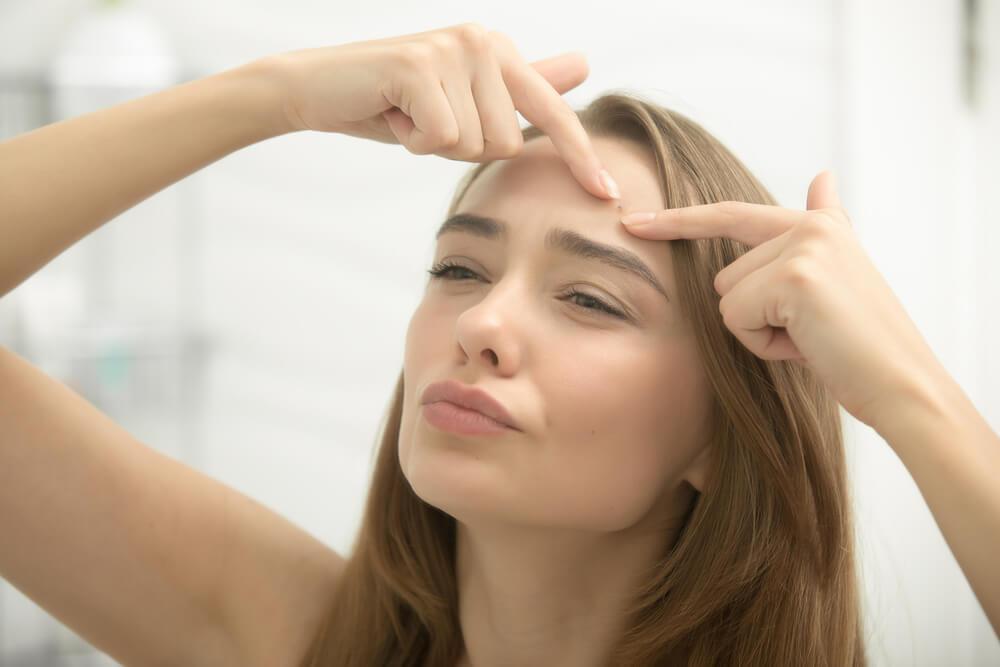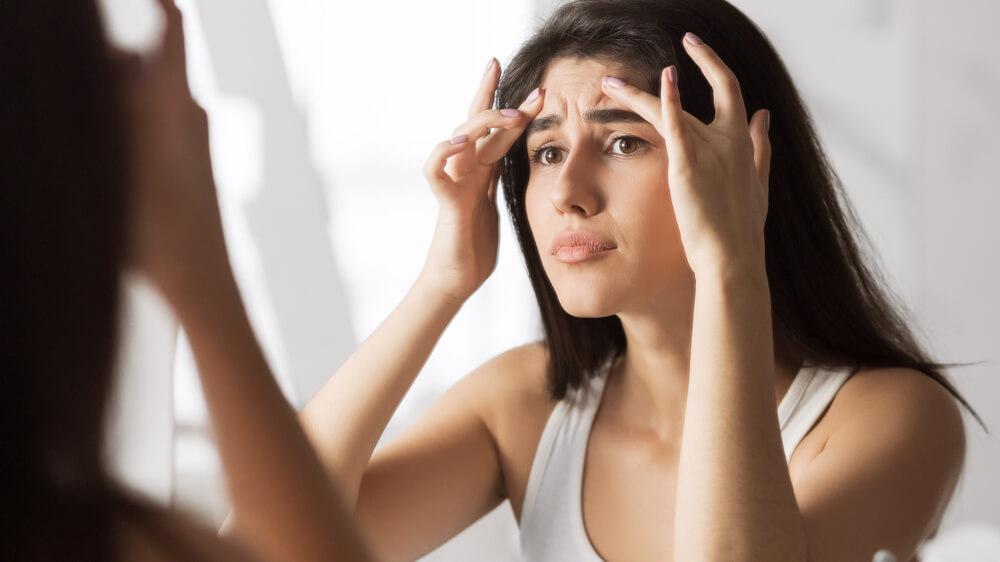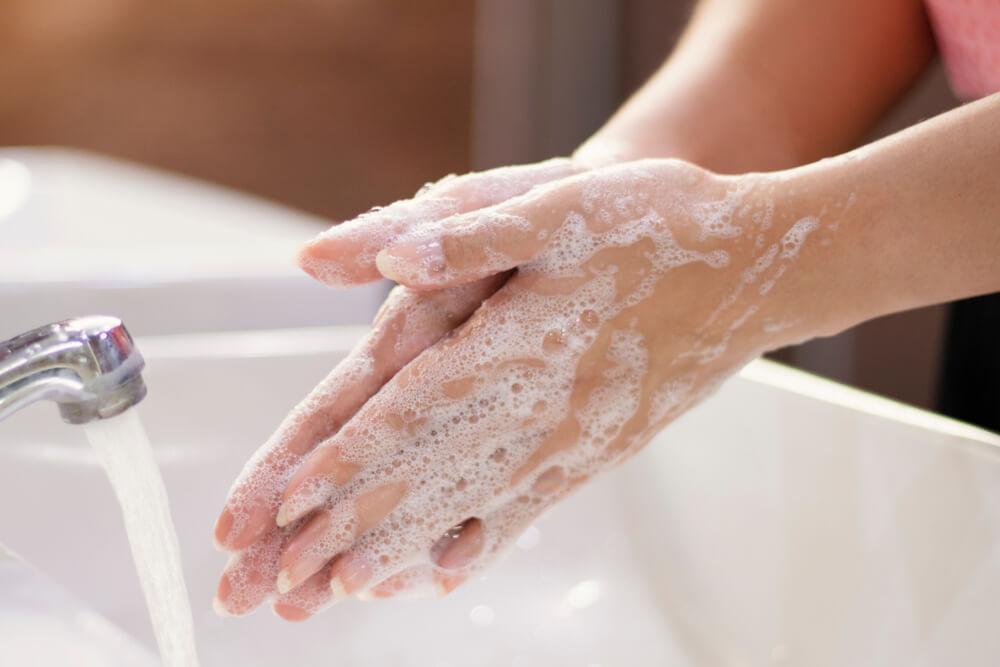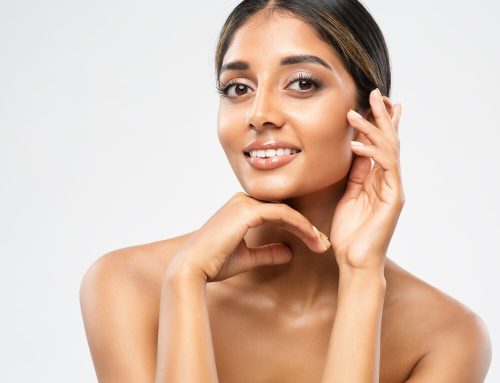
Aside from being slightly uncomfortable at times, forehead bumps are usually not a cause for concern. We might jump to the conclusion that the bumps on your forehead are signs of acne, and that’s not entirely wrong!
However, there are other causes of forehead bumps. Sometimes your forehead may feel uneven but have spots that never actually develop into pus-filled pimples.
Here’s a rundown on what those bumps might be and what you can do about them.
What are These Bumps on My Forehead?
Acne
Acne is fairly common, and almost everyone experiences it, especially adolescents. When the hair follicles in your skin become clogged with oil and dead skin cells, your skin is prone to whiteheads, blackheads, and other types of pimples.
Now, the bumps on your forehead are more likely than not, some type of acne. Here’s an overview of what those are:
- Blackheads, or open comedones, are pores clogged by sebum and dead skin cells. The “black” that appears on the surface is due to the pore still being open.
- Whiteheads, or closed comedones, take longer to treat because the clogged pores have already closed. Whiteheads appear as small bumps on the surface.
- Papules are larger, more inflamed bumps. These are pink around the area and are tender to touch.
- Pustules are the bumps that have white or yellow tops due to the pus within the pore.
More severe acne, such as nodules or cysts, is more painful to touch. These cysts are clogged pores with a combination of bacteria, sebum, and dead skin cells. You should not treat nodules or cysts on your own.
Nodules and cysts are so deeply clogged within the skin that you’ll need more than topical medication. You should not pick at these either, as they are more likely to scar.
It’s always best to check with your primary doctor or dermatologist on treatment options.
Folliculitis

Our bodies, for the most part, are covered in hair, including our forehead. Now, the hairs on our forehead are usually small and unnoticeable. A tiny cavity surrounds each strand of hair at the root. These are called follicles.
As you might have learned, openings in the skin are prone to inflammation.
Folliculitis occurs when your follicles become inflamed or infected. Usually, folliculitis occurs in places where friction is more likely to happen: your thighs, buttocks, neck, and armpits.
However, anywhere there is hair, folliculitis may develop.
Symptoms for folliculitis include:
- Red, white, or yellow bumps
- Soreness
- Itching
- Swelling
- Puss
The infection is usually from staph bacteria or fungi. Infection usually comes from contact with someone already infected and contaminated items like towels, soap, or clothing. Unclean pools and spas are also places you can get infected.
To avoid folliculitis, you should also:
- Avoid wearing tight clothing that causes friction on your skin
- Take care not to get any skin injuries, particularly from shaving.
- Shower immediately after exercise
Here’s the thing: No matter how careful you are, you will still be prone to infections such as folliculitis if your immune system is weakened.
Usually, folliculitis goes away on its own. However, you should see a doctor once you notice anything beyond the bump.
If you have a fever, have a rash, or notice bumps begin to smell or fill up with pus, it’s safest to get checked.
Milia
A Millium cyst is a tiny, white bump that occurs when keratin becomes trapped underneath the skin. These cysts usually form in groups and are called milia.
Milia can occur in anyone of any age. However, Millia is most common in newborns. The causes of milia in newborns are still unknown.
Now, there are two categories to classify Millium cysts: primary and secondary.
Primary Millia forms directly from keratin trapped underneath the skin’s surface. Meanwhile, secondary Millia can occur after damage to the skin.
In older children and adults, the causes include skin damage such as:
- Blistering from a skin condition or rashes
- Topical burns
- Sun damage
- Prolonged use of steroid creams
- Dermabrasion or laser resurfacing
Though usually millium cysts are found on the cheeks, cysts can occur anywhere, including the forehead. In older children and adults, the cysts can go away on their own after a few months.
Of course, if you’re feeling discomfort, there are treatment options for this condition that you can look into with your doctor.
Rosacea
If you’re noticing flare-ups that come and go, accompanied by red, pus-filled bumps on your forehead, it might be rosacea.
Rosacea is a chronic skin disease that affects many. Though the cause is still unknown, flare-ups can be managed by minimizing the symptoms.
You might be asking: what’s the difference between rosacea and acne?
While acne can be a single, isolated case now and then, rosacea happens in cycles. There are several types of rosacea, but common symptoms include:
- Visible, broken blood vessels
- Burning or stinging
- Swelling or redness
- Acne-like pustules
- Vision problems
- Dry, itchy eyes
Though common in women and people with fair skin, anyone can have it.
Contact Dermatitis

Now, you might notice bumps that look more like a rash. Contact dermatitis usually occurs when your skin comes into direct contact with a substance or allergen. Though nothing serious, the inflammation can be very uncomfortable.
Here’s why:
Contact dermatitis rashes are characterized by a red rash that can also be accompanied by severe itching. The skin around the rashes can be dry, cracked, and scaly.
What’s more, bumps and blisters may form. Sometimes, around these bumps or blisters, you’ll find oozing or crusting beginning to occur.
These rashes usually develop within minutes or hours upon coming into contact with the cause. One example is poison ivy. However, common irritants include typical household items such as:
- Rubbing alcohol
- Bleach and detergents
- Shampoos
- Airborne substances, e.g., sawdust
- Plants
- Fertilizers and pesticides
Contact dermatitis can also occur because of substances you are allergic to in particular. Another term for this is allergic contact dermatitis.
Ringworm
In some cases, the bumps on your forehead don’t occur in tiny, individual spots, but in slightly-raised formations.
If these formations are ring-shaped bumps that are itchy, red, and scaly, you might have contracted a ringworm infection.
A fungal infection causes ringworm in the body. Now, if you’re worried about the name, don’t be. The name comes from its appearance and not an actual worm.
Here’s what you need to remember: ringworm is highly contagious and can spread from human to human or animal to human. If you come into contact with a contaminated object, you may also be prone to the infection.
However, you can reduce the likelihood of experiencing a ringworm rash by practicing good hygiene and educating those around you.
How Do I Get Rid of Bumps On My Forehead?
Practice Good Hygiene

You can both get rid of the bumps and avoid recurring instances by practicing good hygiene. So far, from what we’ve learned, most bumps on your forehead happen from infections or irritants.
Even if you’ve never experienced bumps on your forehead, practicing good hygiene is crucial to avoid any rash, lump, or infection.
Here are a few ways to do so:
- Cleanse your face. Because your skin sweats and produces sebum throughout the day, you should make sure to cleanse your skin to avoid clogging.
- Change your sheets and towels often. One way to avoid bacterial and fungal infections is to ensure the items you frequently encounter are clean.
- Try not to touch your face. It might be challenging to do, but because your hands are always touching several items throughout the day, it’s best to avoid touching your face.
- Wash your hands often. Handwashing is the one of the best ways to avoid transferring bacteria from your hands to your face, especially your forehead.
- Avoid sharing personal items with others. You should avoid sharing things like towels with others to avoid infecting each other.
Protect and Moisturize
One great way to help your skin heal from bumps on your forehead, for example, is to keep your face protected and moisturized. Sunblock is essential to avoid prolonged sun damage. Try to opt for sunblocks that are water-based if you’re worried about the cream being too heavy.
As for moisturizers, each product’s effectiveness depends on your skin type and how your skin reacts to the product.
With that, you might also consider learning about skin types and the right products for each.
Besides having soft, smooth-feeling skin, keeping your skin moisturized also prevents further damage that could irritate any existing bumps on your skin.
You can moisturize with a gel or cream after washing, and even go the extra mile by putting on a sheet mask.
Reduce Stress
As with acne, for example, stress is one of the factors that come into play. Now, remember, stress doesn’t directly cause acne or any form of bumps on your forehead.
However, it could further aggravate your condition. When you are stressed, your hormones may be thrown off balance.
Under stress, your body is triggered to produce oil-stimulating hormones.
With that in mind, it’s vital to manage stress. A few ways to do so include yoga, meditation, journaling, a trip to the spa, or aromatherapy. You might even consider fidget jewelry.
Watch What You Eat

Because skin conditions usually have a lot to do with your hormones and immune system, having a well-balanced diet is a plus. You don’t have to be completely healthy. It’s alright to snack and indulge yourself once in a while.
So what should you eat or not eat?
Studies have shown that unhealthy diets, such as a high glycemic diet, may cause acne conditions. High glycemic foods include chips, baked goods made with white flour, and beverages that are high in terms of sugar levels.
Avoiding these foods prevents you from developing acne and allows you to eat more nutritious food, which in turn can fortify your immune system.
Check For Allergies
By now, you have learned that bumps on your forehead can also be caused by allergens or substances you are allergic to.
If you feel you’ve eaten or come into contact with something that has caused a rash or any bump on your skin, you can have yourself checked and assessed by your primary doctor.
Use Over-the-Counter Medications
Mild cases of acne or bacterial and fungal infections can easily be treated at home using over-the-counter medications.
The following are examples of over-the-counter medications you can get:
- Medicated creams or gels. An example is salicylic acid for cases like acne, and blackheads in particular.
- Antifungal creams. Mild cases of ringworm, for example, can be treated with an OTC cream.
- Antihistamine pills. You don’t need only to be sneezing from allergies to take antihistamine pills. If you notice an itch or a rash that might be an allergic reaction, antihistamines can help.
- Anti-itch creams. To get rid of bumps, you need to ensure that you don’t further aggravate your condition by scratching. You can do so by using soothing anti-itch creams
Get Prescription Medication
Sometimes topical treatment alone is not enough to treat the bumps on your forehead. Speak to your doctor if you feel you’ll need something more potent than a cream or gel.
Your doctor may prescribe the following:
- Antibiotics
- Antifungal medication
- Creams or topical retinoids that have a more potent effect
Consider Professional Treatments
By now, you should know that bumps on your forehead may be too deep for surface-level treatment. Your doctor might suggest the following treatments:
- Laser therapy
- Chemical peel
- Extraction
It’s vital to seek a professional’s help when it comes to these treatments.
Should you have it done yourself or by a non-professional, you put your skin at risk of further damage.
Summary
Now, we hope we’ve helped you find what it is you need to get rid of those forehead bumps.
Some bumps on your forehead may be uncomfortable. Other times, it might be challenging to manage, and this may affect your self-esteem. We want you to know that that’s completely okay.
What matters is that you have taken steps to prevent or get rid of them, starting with reading up on this article.






Leave A Comment